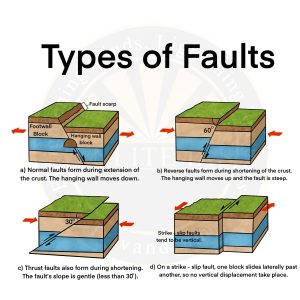Definition
- A fault is a fracture or discontinuity in the Earth’s crust where rocks on either side have moved relative to each other. This movement is caused by tectonic forces such as compression, tension, or shear.
Parts of Fault
- Fault Plane: The surface along which the rocks have moved.
- Hanging Wall: The block of rock above the fault plane.
- Footwall: The block of rock below the fault plane.
Types of Fault
- Normal Fault
- Description: The hanging wall moves down relative to the footwall.
- Cause: Tensional forces (pulling apart).
- Features: Creates rift valleys and block mountains.
- Example: East African Rift Valley.
- Reverse Fault
- Description: The hanging wall moves up relative to the footwall.
- Cause: Compressional forces (pushing together).
- Features: Associated with mountain building.
- Example: Himalayan Thrust Fault.
- Strike-Slip Fault
- Description: Rocks move horizontally along the fault plane.
- Cause: Shear forces (sideways movement).
- Features: Often produces linear valleys or offset streams.
- Example: San Andreas Fault (California).
- Oblique-Slip Fault
- Description: Combines vertical and horizontal movement.
- Cause: Tensional and shear forces combined.
- Features: Complex deformation patterns.
- Example: Faults with mixed movements in tectonic plate boundaries.
- Thrust Fault
- Description: A type of reverse fault where the fault plane has a low angle (less than 45°).
- Cause: Strong compressional forces.
- Features: Often associated with folding and the formation of mountain ranges.
- Example: Rockies and Alps.
- Transform Fault
- Description: A specific type of strike-slip fault found at tectonic plate boundaries.
- Cause: Lateral movement between tectonic plates.
- Features: Associated with earthquakes along plate margins.
- Example: Mid-Atlantic Ridge

